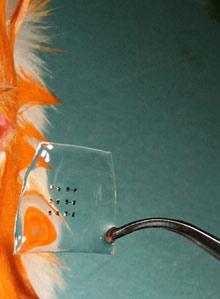
Have you ever dreamed of being a cyborg? Sure, it’s a natural part of going through puberty, but it’s only ever going to be a dream unless scientists can perfect a flexible and reliable way to integrate circuitry into the human body. Thankfully, researchers at Tufts University, University of Illinois Champaign-Urbana, and UPenn have developed tiny silicon circuits that sit on a transparent film. When implanted in a body, that silk completely dissolves over time, leaving just the silicon components which are too small to cause irritation. As reported in a recent article in Applied Physics Letters, the end result is a biocompatable, biodegradable circuit that was successfully bonded onto a mouse. The same circuits could one day provide a better nervous system to machine interface. Or LED tattoos. Either way, it’s going to be exciting.
We’ve seen some amazing technology that connects computers to our nervous system: Braingate, epilepsy controlling shock therapy devices, retinal implants, etc. A consistent problem in these devices, or at the least a limitation, is the way in which metal contacts connect to nerve cells. You can place the contact near the nerve, or pierce the nerve with the contact, but getting the two to touch perfectly is difficult. Even when this is accomplished, the long-term compatibility of the metal isn’t always well known or desirable. That’s where silicon-silk circuits could prove very useful. With a biodegradable film that is flexible and dissolves over time, surgeons could get the circuitry much closer to nerves than before, and in harder to reach folds in the brain, without piercing through connecting tissues. Or in a related use, the silk film could be used to produce circuits that rest near the surface of the skin. We could see LEDs that light up when you’re about to have a heart attack, or that usher in the next generation of body-alteration art.
Research was lead by John Rogers of University of Illinois, and David Kaplan and Fiorenzo Omenetto of Tufts. Rogers has considerable experience with flexible and stretchable silicon circuits, while the Tufts team had been exploring the use of silkworm cocoon proteins. In collaboration with other groups, these researchers were able to create an array of transistors that were each about 1mm long and only 250 nm wide. Gold or titanium metal leads were used to connect the circuit to external contacts.
One of the amazing things about silk film is that a simple saline wash, or even water, will allow it to conform very well to a tissue surface. It’s also already been approved for use in medical implants by the US Food and Drug Administration. As it dissolves in the body it leaves behind harmless by-products. The silicon circuits are likely to be safe as well. Their small size (just nanometers wide) prevent them from causing irritation so far. The gold and titanium leads are not biodegradable, but the next generation of contacts the team uses will be. Overall, the system seems poised to provide an electronics system with unparalleled biocompatibility.
When Ray Kurzweil and others discuss the future of humanity, they often suppose that humans and machines will start to become one and the same. On some level, that’s already happened with the advent of mobile phones and hand held computers. But on the visceral cyborg-with-wires-sticking-out-its-eyes level we’re still a long way off from the marriage of biology and silicon. Work like the biodegradable silicon-silk circuit could lead the way to humans placing more of their electronics inside their own bodies. This could be used to great effect in prosthetics, but may be more popular in cosmetics. Come on, admit it: a watch built into your wrist would be kind of cool.
[photo credit: MIT Technology Review]


